 ResearchSpace
ResearchSpace
Ionic self-assembly of porphyrin nanostructures on the surface of charge-altered track-etched membranes
JavaScript is disabled for your browser. Some features of this site may not work without it.
- ResearchSpace
- →
- Research Publications/Outputs
- →
- Journal Articles
- →
- View Item
| dc.contributor.author |
Mongwaketsi, N

|
|
| dc.contributor.author |
Ndungu, PG

|
|
| dc.contributor.author |
Nechaev, A

|
|
| dc.contributor.author |
Maaza, M

|
|
| dc.contributor.author |
Sparrow, R

|
|
| dc.date.accessioned | 2010-08-26T14:46:02Z | |
| dc.date.available | 2010-08-26T14:46:02Z | |
| dc.date.issued | 2010-01 | |
| dc.identifier.citation | Mongwaketsi, N, Ndungu, PG et al. 2010. Ionic self-assembly of porphyrin nanostructures on the surface of charge-altered track-etched membranes. Journal of Porphyrins and Phthalocyanines, Vol. 14(5), pp 446-451 | en |
| dc.identifier.issn | 1088-4246 | |
| dc.identifier.uri | http://www.worldscinet.com/jpp/14/1405/S1088424610002276.html | |
| dc.identifier.uri | http://hdl.handle.net/10204/4218 | |
| dc.description | Copyright: 2010 Wiley-Blackwell. This is the post print version. The definitive version is published in the Journal of Porphyrins and Phthalocyanines, Vol. 14(5), pp 446-451 | en |
| dc.description.abstract | Track-etched polymer membranes are typically used as templates in the synthesis of various nanowires or nanotubes arrays. The unique advantages of track-etched membranes, such as uniform pore structure, excellent porosity, easily tailored pore sizes, and a well characterized surface chemistry, may find use in self-assembly strategies where colloidal nanostructures can be tethered to a suitable substrate to produce devices of interest. Meso-tetrakis(4-phenylsulfonicacid)porphyrin dihydrochloride and Sn(IV) tetrakis(4-pyridyl)porphyrin were used to synthesize ionic self-assembled porphyrin nanorods. The track-etched membranes surface charge was changed from negative to positive using polyethyleneimine. The porphyrin nanorods were either filtered through or self-assembled onto the surface of track-etched membranes. Comparisons were made with track-etched membranes modified with, and without, poly ethyleneimine. Assembly of the porphyrin nanotubes only occurred on the surface of positively charged track-etched membranes, and filtration of the porphyrin nanorods produced a mesh-like structure on the surface of the membrane irrespective of the track-etched membrane pore diameter. In each case the characteristic absorbance profiles of the porphyrin nanorods was maintained. Transmission electron microscopy, scanning electron microscopy, atomic force microscopy, and UV-vis spectroscopy were used to characterize the various systems. | en |
| dc.language.iso | en | en |
| dc.publisher | Wiley-Blackwell | en |
| dc.subject | Porphyrin nanotubes | en |
| dc.subject | Poly-(ethylene-terephthalate) | en |
| dc.subject | Consolidated nanomaterial | en |
| dc.subject | UV-vis spectroscopy | en |
| dc.subject | Atomic force microscopy | en |
| dc.title | Ionic self-assembly of porphyrin nanostructures on the surface of charge-altered track-etched membranes | en |
| dc.type | Article | en |
| dc.identifier.apacitation | Mongwaketsi, N., Ndungu, P., Nechaev, A., Maaza, M., & Sparrow, R. (2010). Ionic self-assembly of porphyrin nanostructures on the surface of charge-altered track-etched membranes. http://hdl.handle.net/10204/4218 | en_ZA |
| dc.identifier.chicagocitation | Mongwaketsi, N, PG Ndungu, A Nechaev, M Maaza, and R Sparrow "Ionic self-assembly of porphyrin nanostructures on the surface of charge-altered track-etched membranes." (2010) http://hdl.handle.net/10204/4218 | en_ZA |
| dc.identifier.vancouvercitation | Mongwaketsi N, Ndungu P, Nechaev A, Maaza M, Sparrow R. Ionic self-assembly of porphyrin nanostructures on the surface of charge-altered track-etched membranes. 2010; http://hdl.handle.net/10204/4218. | en_ZA |
| dc.identifier.ris | TY - Article AU - Mongwaketsi, N AU - Ndungu, PG AU - Nechaev, A AU - Maaza, M AU - Sparrow, R AB - Track-etched polymer membranes are typically used as templates in the synthesis of various nanowires or nanotubes arrays. The unique advantages of track-etched membranes, such as uniform pore structure, excellent porosity, easily tailored pore sizes, and a well characterized surface chemistry, may find use in self-assembly strategies where colloidal nanostructures can be tethered to a suitable substrate to produce devices of interest. Meso-tetrakis(4-phenylsulfonicacid)porphyrin dihydrochloride and Sn(IV) tetrakis(4-pyridyl)porphyrin were used to synthesize ionic self-assembled porphyrin nanorods. The track-etched membranes surface charge was changed from negative to positive using polyethyleneimine. The porphyrin nanorods were either filtered through or self-assembled onto the surface of track-etched membranes. Comparisons were made with track-etched membranes modified with, and without, poly ethyleneimine. Assembly of the porphyrin nanotubes only occurred on the surface of positively charged track-etched membranes, and filtration of the porphyrin nanorods produced a mesh-like structure on the surface of the membrane irrespective of the track-etched membrane pore diameter. In each case the characteristic absorbance profiles of the porphyrin nanorods was maintained. Transmission electron microscopy, scanning electron microscopy, atomic force microscopy, and UV-vis spectroscopy were used to characterize the various systems. DA - 2010-01 DB - ResearchSpace DP - CSIR KW - Porphyrin nanotubes KW - Poly-(ethylene-terephthalate) KW - Consolidated nanomaterial KW - UV-vis spectroscopy KW - Atomic force microscopy LK - https://researchspace.csir.co.za PY - 2010 SM - 1088-4246 T1 - Ionic self-assembly of porphyrin nanostructures on the surface of charge-altered track-etched membranes TI - Ionic self-assembly of porphyrin nanostructures on the surface of charge-altered track-etched membranes UR - http://hdl.handle.net/10204/4218 ER - | en_ZA |





